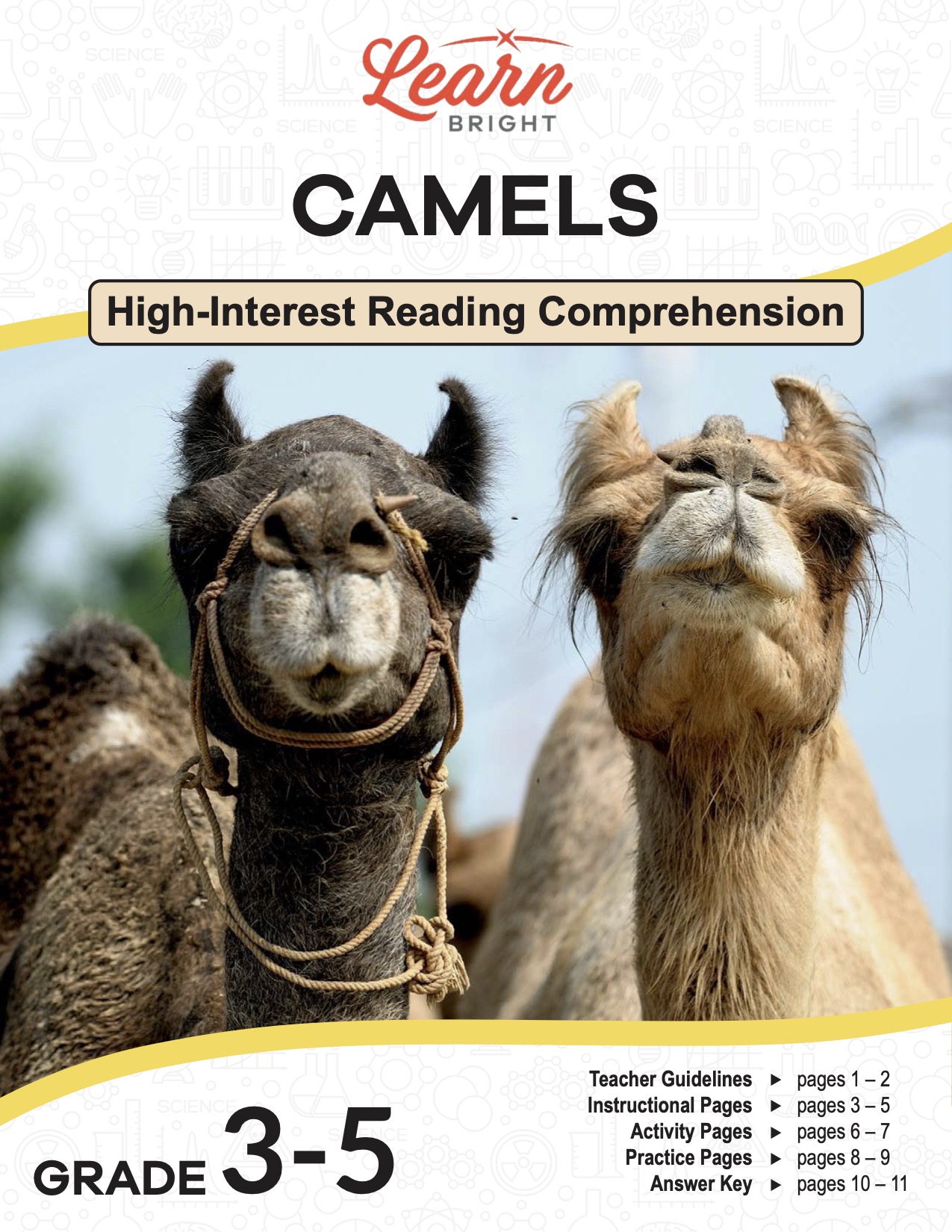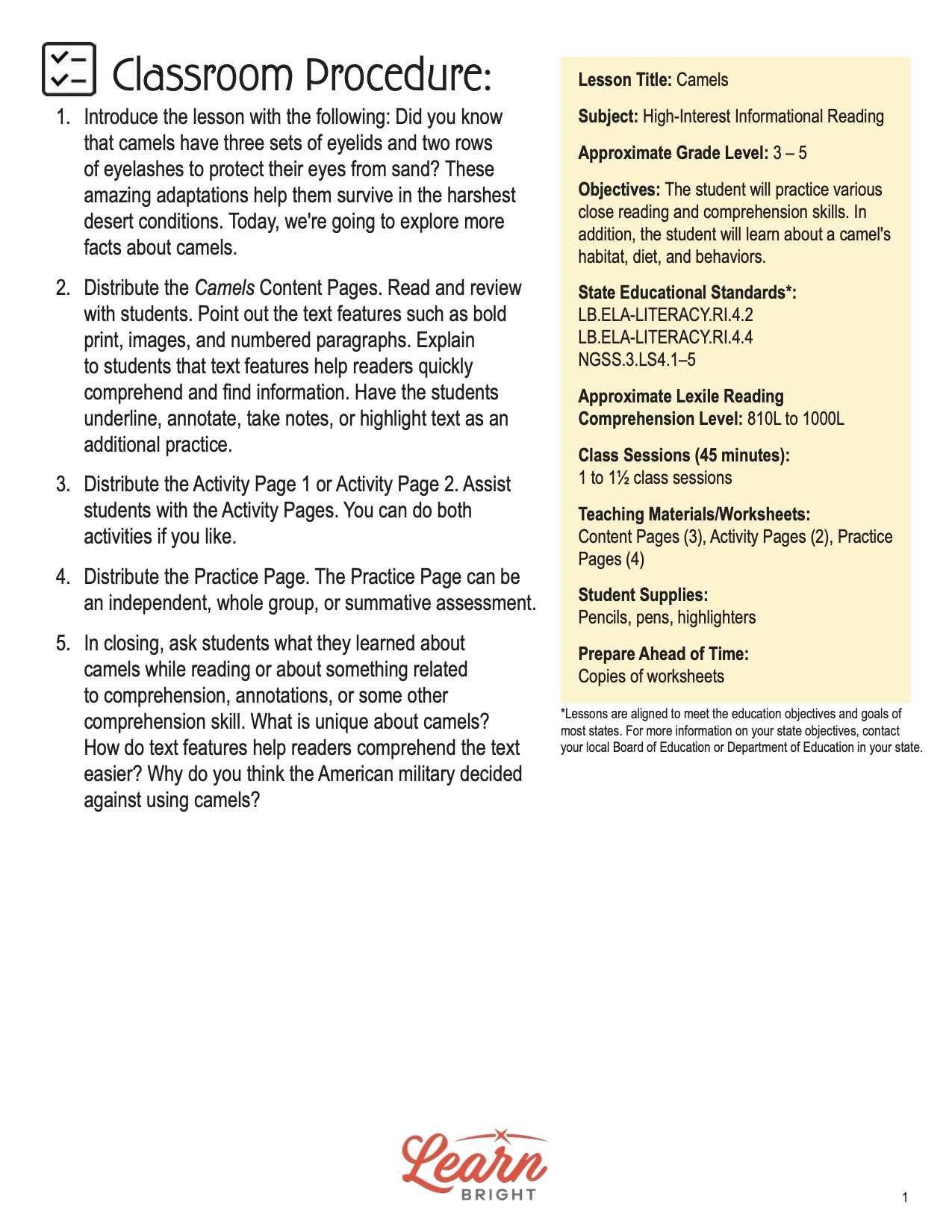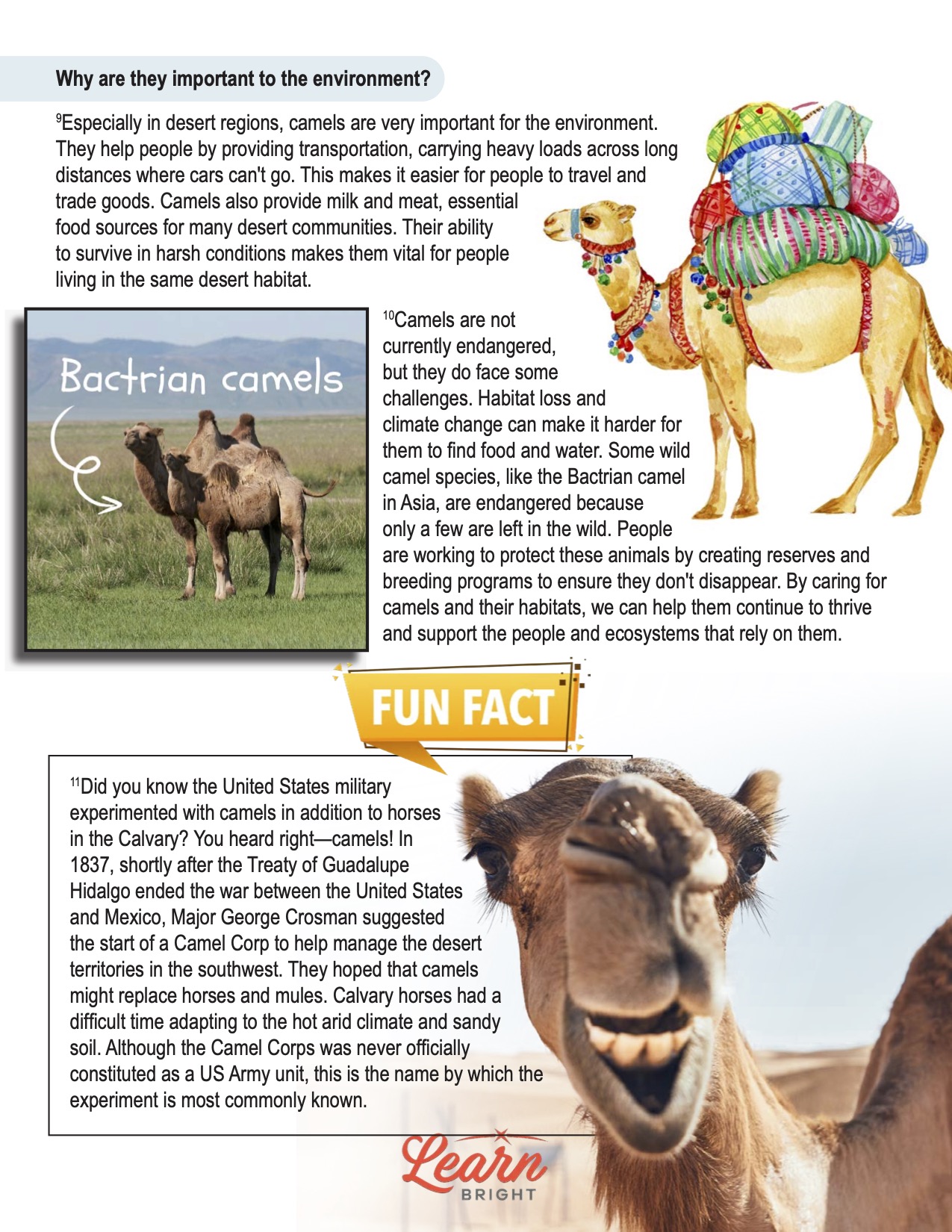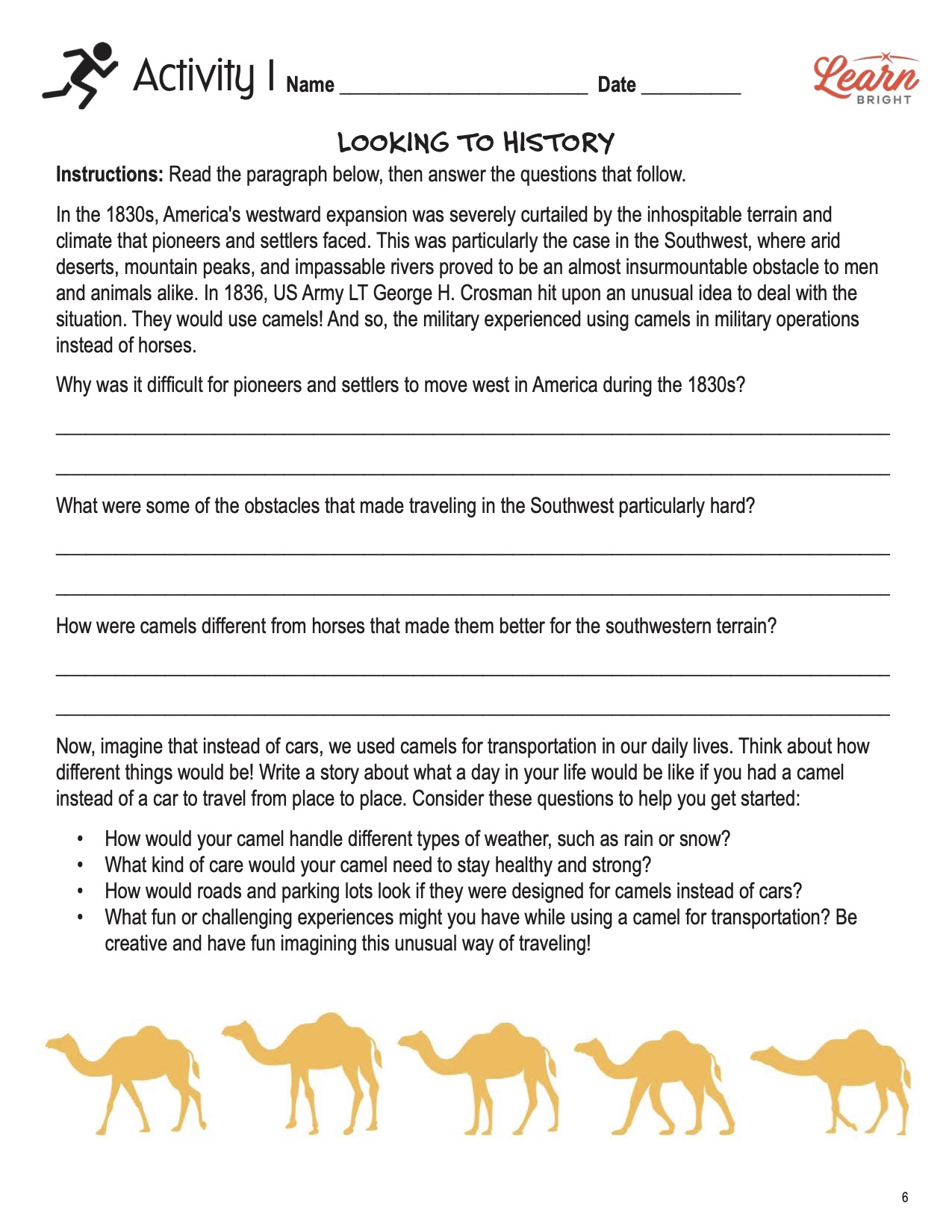Description
What our Camels lesson plan includes
Lesson Objectives and Overview: Camels is a high-interest reading comprehension lesson plan. As such, students will practice various close reading and comprehension skills. In addition, they will learn about the habitat, diet, and behaviors of camels. This lesson is for students in 3rd grade, 4th grade, and 5th grade.
Classroom Procedure
Every lesson plan provides you with a classroom procedure page that outlines a step-by-step guide to follow. You do not have to follow the guide exactly. The guide helps you organize the lesson and details when to hand out worksheets. It also lists information in the yellow box that you might find useful. You will find the lesson objectives, state standards, and number of class sessions the lesson should take to complete in this area. In addition, it describes the supplies you will need as well as what and how you need to prepare beforehand.
Teacher Notes
The paragraph on this page gives you a little more information on the lesson overall and describes what you may want to focus your teaching on. It explains that you can teach this lesson in a whole-class setting or as an independent, small-group activity. The blank lines are available for you to write out any thoughts or ideas you have as you prepare.
CAMELS LESSON PLAN CONTENT PAGES
The Camels lesson plan contains three content pages. It begins by providing a box of background information about this desert animal. Have you ever wondered how camels survive in the scorching desert? Well, they can survive because of some unique traits. Camels have long legs that help them walk across the desert sand easily. Their bodies store fat in humps, which they use as a source of energy when food and water are scarce. They also have thick fur to protect them from the hot sun and sand. Plus, they can close their nostrils to avoid getting sand in their noses during storms. Their long eyelashes and ear hairs also help keep sand out of their—well, eyes and ears!
Camels typically live in groups called herds, which provide them with protection and social interaction. These herds consists of females and their young and a dominant male that leads the group. They are well-adapted to life in harsh environments such as deserts in Africa and Asia, where temperatures can be extremely high during the day and very low at night.
When it comes to caring for their young, camels are very attentive. A mother camel, also called a cow, will nurse her calf for up to 18 months, providing it with essential nutrients. Calves can walk shortly after birth but stay close to their mothers for protection and guidance. The bond between a mother and her calf is strong, ensuring the calf learns to find food and water in the harsh desert environment. This nurturing behavior helps young camels survive and thrive in their challenging habitats.
Diet of a Camel
Camels are herbivores, which means they eat plants instead of animals. But there aren’t many plants in the desert, so camels must eat whatever they can find. They spend a lot of their time searching for plants to consume. When they find a good spot with enough food, they use their strong necks to reach high branches or bend down low to the ground. They munch on dry grasses, leaves, and even thorny plants that other animals might avoid. Camels have tough lips and strong teeth that help them chew these rough plants without getting hurt.
These furry mammals also have unique stomachs that help them survive in the tough desert environment. Their stomachs have three chambers, which allow them to break down the rough, dry plants more efficiently. This multi-chambered system allows camels to extract the maximum nutrients from their food, even when food is sparse. When a camel eats, the food first goes into the rumen, where it is partially digested and then regurgitated as cud. The camel chews the cud thoroughly before swallowing it again, allowing for better digestion. By doing this, camels get the most energy possible from their food.
Interesting Camel Facts
One fascinating fact is that camels can go for several days without water. They have special cells in their bodies that can store water in a way that allows them to survive in hot deserts where water is hard to find. When they do drink water, they can drink up to 40 gallons in one go! This amazing ability keeps them hydrated for long periods.
Another interesting fact is that camels have wide, padded feet that help them walk on sand without sinking. Their feet are like snowshoes, spreading their weight evenly to travel across soft, shifting desert sands. Camels also have a unique way of walking called pacing, where both legs on the same side of their body move forward simultaneously. This gait helps them move smoothly and conserve energy during long journeys.
Camels are also known for their ability to adapt to extreme temperatures. They can handle both scorching heat and freezing cold. In the hot desert sun, their thick fur protects them from sunburn and keeps them cool by reflecting sunlight. During cold desert nights, the same fur keeps them warm. Additionally, camels can change their body temperature to avoid sweating and losing precious water, showing how well-suited they are to their environment.
Why Camels Are Important to the Environment
Especially in desert regions, camels are very important for the environment. They help people by providing transportation, carrying heavy loads across long distances where cars can’t go. This makes it easier for people to travel and trade goods. Camels also provide milk and meat, essential food sources for many desert communities. Their ability to survive in harsh conditions makes them vital for people living in the same desert habitat.
Camels are not currently endangered, but they do face some challenges. Habitat loss and climate change can make it harder for them to find food and water. Some wild camel species, like the Bactrian camel in Asia, are endangered because only a few are left in the wild. People are working to protect these animals by creating reserves and breeding programs to ensure they don’t disappear. By caring for camels and their habitats, we can help them continue to thrive and support the people and ecosystems that rely on them.
Fun Fact!
Did you know the United States military experimented with camels in addition to horses in the Calvary? You heard right—camels! In 1837, shortly after the Treaty of Guadalupe Hidalgo ended the war between the United States and Mexico, Major George Crosman suggested the start of a Camel Corp to help manage the desert territories in the southwest. They hoped that camels might replace horses and mules. Calvary horses had a difficult time adapting to the hot arid climate and sandy soil. Although the Camel Corps was never officially constituted as a US Army unit, this is the name by which the experiment is most commonly known.
CAMELS LESSON PLAN WORKSHEETS
The Camels lesson plan includes three worksheets: two activity worksheets and a practice worksheet. Each one will help students solidify their grasp of the material they learned throughout the lesson. You can refer to the classroom procedure guidelines to know when to hand out each worksheet.
LOOKING TO HISTORY ACTIVITY WORKSHEET
The first activity requires students to read through a paragraph about how the US almost used camels to explore the West. After the finish reading, students will three questions. Then they will write a story about what it would be like to use camels for transportation rather than cars or horses or other modes.
COMPARE AND CONTRAST ACTIVITY WORKSHEET
For the second activity, students will compare and contrast a camel to a horse. First, they will write the differences in the columns. Then, they will write any similarities they can think of in the box at the bottom of the page.
CAMELS PRACTICE WORKSHEET
The practice worksheet lists 11 questions based on the content. These questions all relate to the content pages, so students will need to refer to them often for the answers. In addition, each question provides which reading tool the question corresponds to, such as text feature, vocabulary, or comprehension.
Worksheet Answer Keys
At the end of the lesson plan document is an answer key for the practice worksheet. The correct answers are all in red to make it easier for you to compare them with students’ responses. If you choose to administer the lesson pages to your students via PDF, you will need to save a new file that omits these pages. Otherwise, you can simply print out the applicable pages and keep these as reference for yourself when grading assignments.










